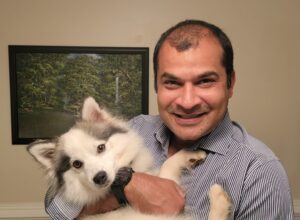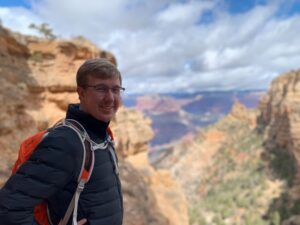By Lisa Farr, M.Ed. Director, Exercise Physiology Core Lab
Interview with Siddhartha Angadi, Ph.D., Department of Kinesiology, Curry School of Education, and Nathan Weeldreyer, MS, doctoral student, Kinesiology
The good news is that we’ve learned a lot about treating cancer: the number of cancer survivors in 2019 was an estimated 16.9 million, and this number is expected to increase to 22.2 million by 2030. But the care of a cancer patient doesn’t end with treating or curing the original cancer. We know that cancer treatment, such as chemotherapy, creates a host of downstream problems, including a high burden of cardiovascular disease and neuropathy (nerve damage) and decreased quality of life.
Ovarian cancer has a 5-year survival of approximately 48% and ranks fifth in cancer deaths among women in the US. With advances in treatment over the past decade, survivorship has progressively increased. As women survive longer, the downstream consequences of chemotherapy are increasingly recognized. Commonly used chemotherapeutic agents are toxic to the heart, and increase the risk of hypertension, heart failure and stroke. Additionally, survivors of ovarian cancer have lower peak oxygen uptake (VO2peak) when compared to normal controls. VO2 peak equals cardiac output (heart rate x stroke volume) x AVo2 difference (the ability of the muscles to take in and use oxygen) and thus reflects the health of many important body systems. VO2 peak is an important predictor of future cardiovascular disease and death, and provides information about fitness level.
Exercise initiated prior to chemotherapy and continued throughout treatment has promise in preserving VO2 peak and mitigating some of the negative cardiovascular and neuropathic effects. It is a powerful, tissue specific antioxidant that protects tissues from chemotherapy induced oxidative stress. It also helps reduce the high blood pressure typically seen after treatment. Previous studies have suggested that high intensity exercise training may be better than more moderate exercise in this regard.
These benefits of exercise before and during chemotherapy have not been studied in ovarian cancer patients. Thus, Dr. Angadi, along with his colleagues Susan Modesitt, MD, and Bethany Horton, Ph.D, received a 3Cavalier grant to study “Exercise Preconditioning in Ovarian Cancer and Cardiotoxicity”
Questions and Answers with Sid Angadi, Ph.D. and his doctoral student Nate Weeldreyer
Question
Why did you want to study exercise before and during chemotherapy?
Answer
Sid: Five years ago when I was at Arizona State a physician I worked with mentioned the heart damage seen after chemotherapy. It got me thinking—how do we change this? You don’t want to help these patients survive cancer only to have them die from heart disease or suffer a poor quality of life due to heart failure. At that time there was still a reluctance in the clinical world to have patients exercise during chemotherapy. There was a fear that exercise could make things worse. We, and others, did studies in animals showing that exercise could be protective when initiated before chemo, and I was involved in my first study with cancer patients. (breast cancer) Exercise is a smart drug that does what is needed.
Nate: What got me interested was a bit more personal: When I was an undergraduate, my girlfriend’s mother was diagnosed with cancer. I chose this topic to do for a research review for a class I was taking, and this piqued my interest in the potential of exercise to help cancer patients.
Question
So what is the real-life application of your study?
Answer
Sid: We hope that exercise before and during chemotherapy will prevent the loss of function, the reduction in quality of life, in these women. We hope they will maintain their VO2 peak and heart function, instead of seeing both decline. Typically, VO2 peak will decrease within months of starting chemotherapy—a few months of chemo roughly equals ten years of aging. So, realistically, we are not trying to improve VO2 peak as much as trying to ‘hold the line.”
Study Specifics
Surgeons will identify potential candidates in clinic and discuss the study with them. If they enroll, about a month after surgery, the study team will begin doing some tests to look at heart and vascular function, as well as body composition. The subjects will do a VO2 peak test on a bike, and have an echo of their heart. The team will do lab work, tests to evaluate for neuropathy, and questionnaires to assess symptoms and quality of life. Subjects will be randomized to standard of care or high intensity interval training. Subjects who are randomized to exercise will receive a few supervised sessions to make sure they understand how hard to exercise once they are on their own. The study provides stationary bikes so that subjects can complete the majority of their exercise training at home. Subjects will do a program that looks like this: warm up; a few 4 minute bouts of hard cycling at a heart rate of 85-90% of the maximum achieved on their VO2 peak test, interspersed with3 minutes of lighter exercise recovery, then a cool down. The study provides heart rate/activity monitors so that the team can track what the subjects do, and subjects also receive regular phone calls to check in. This continues all through chemotherapy, and then the subjects come back to the lab for post testing—VO2 peak, echo, labs—all the same tests they had before chemo started.
This study is HSR 210169, and just completed its first subject.
While catching up with Sid and Nate about their important study, we took the time to get a little personal too.
Question
What is your exercise of choice?
Answer
Sid: I am a believer in the high intensity interval training. I basically do this twice per day with my dog. We go out for 2 miles in the morning and 2 miles in the evening, and do intervals of harder walking (ie up the hills in our neighborhood) interspersed with recovery (walking flat or slower) This tires him out in an efficient way and allows me to get in some good exercise too.
Nate: I like to bike outdoors, hike, and walk my dog. I believe its important to do stuff you enjoy.
Question
If you could give advice to your younger self what would it be?
Answer
Sid: Be less sure of what you think works. And also, realize that a menu of options will work best for most people with clinical conditions…it might be just exercise, but probably its exercise + medication or some other treatment.
Sid returned to UVA about a year ago—he was here as a master’s student. He is pictured here with Monty, his partner in high intensity interval training.

